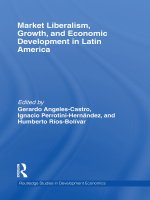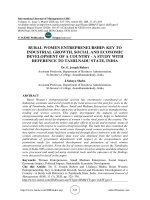Economic growth and economic development 72
Bạn đang xem bản rút gọn của tài liệu. Xem và tải ngay bản đầy đủ của tài liệu tại đây (117.23 KB, 1 trang )
Introduction to Modern Economic Growth
Proposition 2.3. Suppose Assumptions 1 and 2 hold and f (k) = af˜ (k). Denote the steady-state level of the capital-labor ratio by k∗ (a, s, δ) and the steady-state
level of output by y ∗ (a, s, δ) when the underlying parameters are a, s and δ. Then
we have
∂k∗ (a, s, δ)
∂k∗ (a, s, δ)
∂k∗ (a, s, δ)
> 0,
> 0 and
<0
∂a
∂s
∂δ
∂y ∗ (a, s, δ)
∂y ∗ (a, s, δ)
∂y ∗ (a, s, δ)
> 0,
> 0 and
< 0.
∂a
∂s
∂δ
Proof. The proof follows immediately by writing
f˜ (k ∗ )
δ
= ,
∗
k
as
which holds for an open set of values of k∗ . Now apply the implicit function theorem
to obtain the results. For example,
∂k∗
δ (k∗ )2
= 2 ∗ >0
∂s
as w
where w∗ = f (k∗ ) − k∗ f 0 (k∗ ) > 0. The other results follow similarly.
Ô
Therefore, countries with higher saving rates and better technologies will have
higher capital-labor ratios and will be richer. Those with greater (technological)
depreciation, will tend to have lower capital-labor ratios and will be poorer. All of
the results in Proposition 2.3 are intuitive, and start giving us a sense of some of the
potential determinants of the capital-labor ratios and output levels across countries.
The same comparative statics with respect to a and δ immediately apply to c∗ as
well. However, it is straightforward to see that c∗ will not be monotone in the saving
rate (think, for example, of the extreme case where s = 1), and in fact, there will
exist a specific level of the saving rate, sgold , referred to as the “golden rule” saving
rate, which maximizes the steady-state level of consumption. Since we are treating
the saving rate as an exogenous parameter and have not specified the objective
function of households yet, we cannot say whether the golden rule saving rate is
“better” than some other saving rate. It is nevertheless interesting to characterize
what this golden rule saving rate corresponds to.
58









